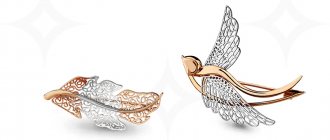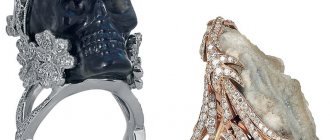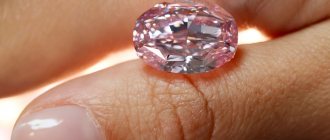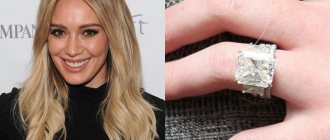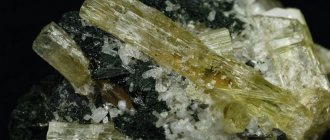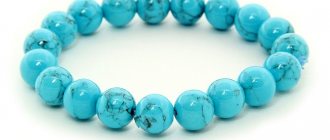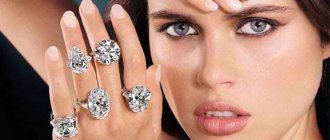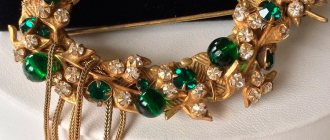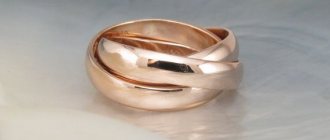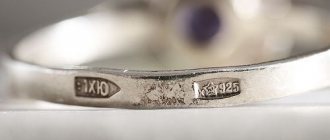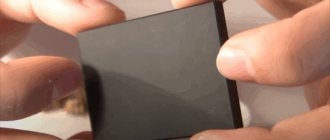During the times of the former Soviet Union, people, as now, knew that gold was the most stable object for investment. Gold samples in the USSR and their table were not very diverse. This happened because the country, isolated from the rest of the world, decided to establish a single gold standard for everyone in the form of 583.
This gold could have different shades, depending on the metals added to it. The color could be reddish, green or tinged with pink. Many people still don’t understand why the number 583?
The value of gold is measured in carats, the number 24 is the maximum value, which means that the jewelry is made of pure gold. The 583rd hallmark is equal to 14 carats, if divided by 24, we get 0.583333.
Sample history
Since the times of the Soviet Union, people have become accustomed to believing that 583 gold is the best. But this is not entirely true: those who understand alloys immediately understood this. But for many ordinary people this was a big discovery. Evidence that gold is not of the highest quality is its deteriorating appearance, namely darkening many years after its purchase.
But Soviet jewelry has another useful feature - it is very durable and difficult to deform. This was done so that the thin rings, which were one of the best-selling rings at that time, would not bend and confuse buyers. If you compare the price per ounce of gold then and now, it has increased by $1,400. Given the rise in price, people are trying to buy products of the highest standard.
What was the standard of gold in Soviet times?
In 1922, during the formation of the USSR, a gold sampling system developed back in 1798 was used. Then the calculation was based on the Russian pound, which included 96 spools.
The famous Soviet standard is 583 gold.
Since 1927, it has lost its meaning. The metric system was adopted. According to it, the sample shows the number of milligrams of noble metal in 1 gram of alloy per 1 kg. This calculation was borrowed from Europe.
The same calculation together with foreign countries made it possible for the Union to develop in the foreign market for precious metals.
To achieve this, the process of measuring gold purity for USSR jewelry was adjusted to generally accepted standards. The selection of samples was small. The country wanted to approve a single gold standard for everyone in the 583rd standard form.
Composition and its connection to the shade of products
As was said earlier, there is a certain dependence of the color indicators of the decoration on the metal that was used for the alloy and obtaining the sample. In Soviet gold of 583 samples, accordingly, there was 58.3% pure gold, and the rest were additives in the form of silver, palladium or copper.
The table shows the color of this gold sample in the USSR in percentage terms:
| Try | Silver | Nickel | Zinc | Copper | Gold | Color |
| 583 | 8,3 | — | — | 33,4 | 58,3 | Red |
| 583 | 18,3 | — | — | 23,4 | 58,3 | Pink |
| 583 | 36,0 | — | — | 5,7 | 58,3 | Green |
| 583 | — | 17 | 8,7 | 16,0 | 58,3 | White |
Hallmark 583 in the modern world: how jewelers and pawnshops evaluate it
After several decades, 583, the old standard of gold, fell from the first place in the popularity of precious metals. Today, disputes arise less and less frequently compared to 585 and 583 samples. However, the price of 585 samples is several hundred rubles per gram higher than the cost of its competitor.
Foreign jewelers speak negatively about 583 samples. However, their negative attitude is not true. 583 standard gold in the USSR, with proper maintenance, does not lose its beauty, because it has:
- radiance that does not disappear for years;
- bulkiness and reliability, which avoids damage;
- corrosion resistance.
585 gold wedding ring
Price
For 2021, the price of 583 gold and 585 gold is practically the same. It ranges from 2900 to 6000 rubles. As for the pawnshop, the price per gram will not exceed the threshold of 1,700 rubles.
In Ukraine, the situation is similar: both samples are sold and bought at almost the same price. Here you can get about 1000 UAH per gram, but the amount more or less directly depends on a number of indicators, for example, on the manufacturer. In a Ukrainian pawnshop they will give no more than 600 UAH per gram of Soviet gold.
Shade of gold and purity - is there a connection?
Does the gold standard depend on the shade of the product? Does 585 gold have a red tint? All of these statements are incorrect because the color of gold largely depends on the impurities added to the alloy. Only a subtle shade of the product can be the fact of the presence of pure gold in the total mass of the jewelry product. The myth about the dependence of the shade of jewelry on the percentage of pure gold content became widespread thanks to the Soviet Union. At that time, products made from 750 gold were yellow, 375 were pink, and 585 were red, which was due to the traditions of the jewelry industry in the USSR.
Reason for popularity
Gold of 583 and 585 samples still remains popular in Russia. It is almost impossible to distinguish them; only a professional can do this, but more on that a little later. What made this gold so popular and sold even in our time?
In the Soviet era, products were largely valued because of their reliability and resistance to wear and other external irritants. The jewelers understood this very well and worked to achieve the desired result. Those who did not neglect the care of the condition of the products, until our time, were able to preserve them in the form in which they were at the time of purchase.
Interesting! The most purchased standard in Europe today is the 750 mark. She is also popular among accomplished people in Russia.
Where was the 583 sample used?
The test was used for almost all types of jewelry. This includes bracelets, pendants, chains, and rings. Large rings were especially popular; they could weigh more than some bracelets. If you find them now, their appearance will be almost identical to how they were when you purchased them.
At the moment, this sample can be found rarely, since it is not accepted internationally and is considered a second-class alloy.
Now people are well aware of this, and in order not to risk their reputation, they do not buy such jewelry.
But at the same time, gold is popular in certain circles. Many people order custom jewelry made from this gold. Things made in the old style are especially beautiful. An alloy is used for them, which will give a reddish tint.
At the moment, if the sample is used, then for the following items:
- wrist watch,
- accessories,
- pens,
- keychains,
- piercing earrings,
- souvenirs,
- products for decoration.
The fate of gold after Stalin
After the reign of Khrushchev N.S. There were a little more than 1,500 tons left in reserves, and after Brezhnev, stocks fell to 400 tons. But Andropov Yu.A. was able to increase reserves and almost doubled them. The most severe blow to the state gold treasury was dealt by M.S. Gorbachev.
By the year 91 of the last century, the gold reserves of the USSR amounted to about 300 tons and, together with all debts, were transferred to the management of Russia. A promise was made to increase the stockpile to almost a thousand tons, but the new government ultimately accepted only just over 350 tons of gold.
Care Tips
Despite the quality and reliability of the jewelry, it tends to darken due to the ligature contained in the composition. When in contact with the human body and oxygen, gold will change; to prevent this from happening, the following actions can be included in preventive measures:
- you need to add up to 5 drops of ammonia to a glass of soap solution,
- decorations are placed in water for 20 minutes,
- Having taken out the product, rinse it with ordinary tap water,
- Depending on the contamination, you need to either clean the jewelry with a soft brush or simply wipe it with a napkin until it shines.
Important! Such a product should not be exposed to aggressive substances in the form of acids and alkalis, which may be contained in household chemicals. This may ruin the appearance, making it impossible to restore the earrings or rings.
Is it true that Soviet jewelry is of better quality than modern jewelry?
We often hear that gold used to be better. Is this really so and how did Soviet-era jewelry differ from modern ones?
In Soviet times, jewelry was a real luxury. Ordinary women either did not have them at all, or they were carefully kept in a locked sideboard and worn only on special occasions; it was not customary to wear them every day. Few people could afford diamonds, and knowledgeable buyers looked for jewelry on consignment shops.
Gold rings, rings and earrings were of family value. They were given to girls for weddings or for the birth of children, passed down from grandmothers and kept for decades in a treasured box. The jewelry industry in Soviet times was nationwide, and the range was quite limited. Nowadays the shelves of jewelry stores are full of jewelry, the stores are filled with jewelry, but there is still an opinion that the quality of the jewelry itself was better, the gold was higher quality, and the stones were cleaner. Is it really?
Mandatory sample and stamp
The sample standard appeared after the Revolution. Then a stamp appeared with the image of a worker with a hammer and an alphabetic code, which was later replaced by a star with a hammer and sickle. The mark was affixed to all jewelry that met one of the standards specified in the USSR.
The sample showed the content of precious metal in one thousand weight units of the alloy from which the product was made.
In the USSR there were several samples: for platinum jewelry 950°, for gold jewelry 375°, 500°, 583°, 750° and 958°.
All jewelry was produced only in the 1st grade; some products made of amber and non-ferrous metals were allowed to be produced in the 2nd grade, but this was necessarily indicated in the documentation.
Jewelry was made to last forever. Durable and weighty rings with large stones that held thick paws could be worn for decades and passed on to children and grandchildren. The thicker the metal, the stronger it is: you won’t bend it, you won’t break it, and the stone won’t fall out. All the stones were securely fastened, and the clasps of the products almost did not break.
As for the quality of gold itself, there was a single GOST, which clearly stipulated the percentage of all metals. Now in the Russian jewelry industry there is also an OST for gold content, it must be at least 58.5%, but the content of other metals is no longer strictly determined. Modern products may contain more gold, but other metals may be different. This sometimes affects the quality and properties of modern products. To make the design beautiful, the metal is given low fusibility, which makes it easier to compress and wear out. So modern jewelry is much thinner and more elegant, they can indeed break or bend and require more careful handling.
Gems: natural or synthetic?
Large rings with a bright red ruby or a more elegant alexandrite became a symbol of the era. But if we talk about the authenticity and naturalness of Soviet stones, then in most jewelry they were artificially grown. They learned how to synthesize stones a very long time ago, even before the Revolution, so, to the surprise of many owners of grandmother’s antique jewelry, they often turn out to be artificial.
Since the 70s of the last century, scientists have obtained technology for the synthesis of purple-red corundum. These 1- and 2-carat stones, which appeared on the market in the 1880s, were called “Geneva rubies.”
In the 1980s, scientists from the Lebedev Physical Institute managed to grow an artificial diamond, cubic zirconia. This was a real breakthrough in the jewelry industry. Soviet citizens were not at all embarrassed that the stone was synthetic, and rings, earrings and pendants with cubic zirconia created a real sensation among fashionistas of the Soviet Union.
As for the familiar Soviet rubies, sapphires, tourmalines and alexandrites, most of them were also artificial. Pure natural gem quality stones have always been rare and sometimes cost more than diamonds.
Rings and earrings with large stones, popular among Soviet women, are artificially grown, but this does not mean that old Soviet jewelry has no value. Synthetic Soviet stones are of the highest quality and can be very beautiful.
Anna Zalesskaya / Domashny Ochag magazine
(Visited 1,763 times, 1 visits today)
The role of Turkish gold
In the 80s and 90s, the 585 sample began to cause indignation among the Soviet people. This was due to the massive import of jewelry of this standard from Turkey, which was made using gold foil. These products fell apart and deteriorated from any unconventional influence on them, and also faded, changing their color, and were not durable, easily bent and deformed.
The same goes for precious stones. Their crafts were widely used for gold inserts. They were also not resistant to environmental irritants, and already in the first months they deteriorated and changed their color. Numerous complaints about the poor quality of the product provoked a ban, which was introduced in 2000.
After some time, gold from domestic producers returned to the shelves. It was of much better quality and did not cause any indignation on the part of buyers.
Vintage jewelry to create original looks
Soviet gold jewelry from the USSR era is a range of memorable designs that can be used in modern looks! Such models are likely to be found in almost every family, which does not reduce their merits! How to wear Soviet jewelry today?
- “Raspberries” are colored stones surrounded by a circle of colorless ones. Earrings and rings “raspberries” are a variant of the “halo”; this arrangement of inserts remains a hit to this day. The advantages of “raspberries” are that even a small central stone in them looks luxurious due to the surrounding of small crystals. You can wear the Soviet “raspberry” in any elegant look; such models still look relevant today.
- “Tulips” - a large or medium-sized stone is sandwiched in a golden “tulip” of pronged petals. “Tulip” was used for earrings, rings and even watches. The insert seems to float in them, it is clearly visible from all sides, and the mount itself is very decorative. Today, “tulips” are hardly made because if you use a real gemstone, they would cost a fortune. You can use the laconic “tulips” that you inherited in business looks with a retro touch.
- “Sudarushki” are patterned (openwork or embossed) Soviet earrings made of gold in the form of an inverted kokoshnik, usually without inserts. They contain Slavic motifs, and this is a wonderful detail to the ethno-image.
- Turban rings are large rings without inserts with a flared front part and a rounded shape. Fits perfectly into the oversized trend!
- The “Shakhin” ring is a real hit of the USSR, the dream of every Soviet woman! The ring was decorated with a huge oblong stone set in a wide openwork base, tapering towards the back of the product. Now such a ring can be worn by girls who are no strangers to self-irony, because the fact that the stone is artificial is obvious. “Shakhinya” fits well into the mix of rings, becoming its accent.
